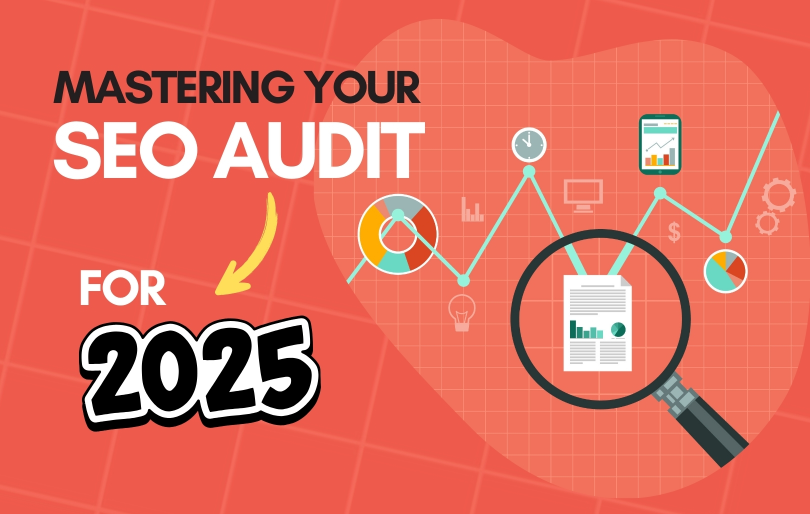Mastering Your SEO Audit for 2025: Essential Strategies to Boost Your Rankings
As we approach 2025, the digital landscape is evolving faster than ever, making a thorough SEO audit an indispensable tool for online success. Mastering your SEO audit for 2025 not only uncovers hidden opportunities but also equips you with essential strategies to elevate your website’s rankings. Whether you’re a seasoned marketer or a business owner navigating the complexities of search engine optimization, understanding the nuances of an SEO audit can dramatically influence your visibility and traffic. This article will guide you through the critical aspects of conducting an effective audit, focusing on actionable insights that can propel your site to the forefront of search engine results. Prepare to delve into the essential strategies that will not only refine your current practices but also adapt to the changing algorithms and user behaviors of tomorrow. Your journey to mastering SEO starts here—let’s unlock the potential of your website together! For an overview of current best‑practice benchmarks, explore our guide to best SEO practices for 2025 before you dive in.
Understanding the Importance of an SEO Audit
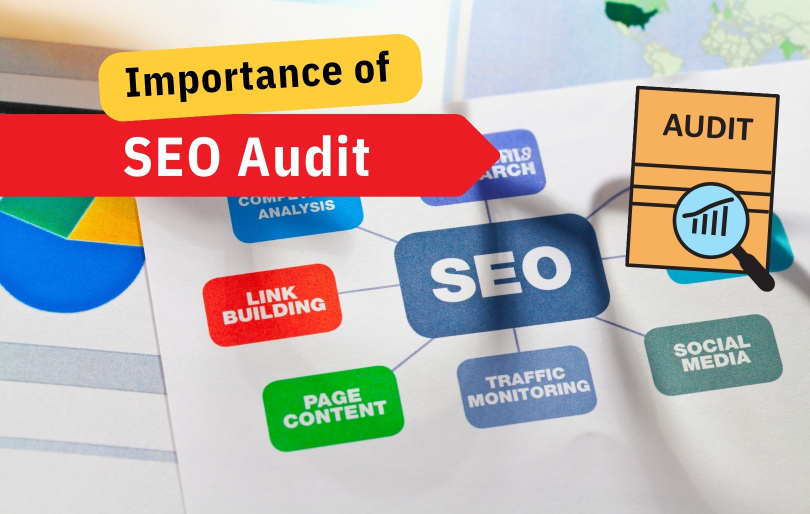
As we stand on the brink of 2025, the digital marketing landscape continues to shift and evolve at a rapid pace. An SEO audit is a critical tool for ensuring your website remains competitive in this dynamic environment. By systematically reviewing your site’s SEO performance, you can identify weaknesses, capitalize on strengths, and stay ahead of the curve. This meticulous process helps you understand where your site stands in the crowded field of search engine results pages (SERPs) and what steps you need to take to improve. A solid audit lays the groundwork for ranking gains—see our roadmap on how to rank higher on Google in 2025 for proof.
SEO audits are not just for identifying the current state of your website but also for uncovering hidden opportunities that can propel your site forward. They provide a comprehensive analysis of various factors that influence your search engine rankings, such as on-page elements, technical structure, and backlink profiles. This holistic approach ensures that all aspects of your SEO strategy are aligned with best practices and current trends.
Moreover, regular SEO audits are essential for adapting to the constant changes in search engine algorithms. Search engines like Google frequently update their algorithms to provide users with the most relevant and high-quality results. By conducting periodic audits, you can ensure your website remains compliant with these updates and continues to perform well in search results. In essence, an SEO audit is a proactive measure that keeps your website optimized and ready to meet the challenges of an ever-changing digital world.
Key Components of an Effective SEO Audit
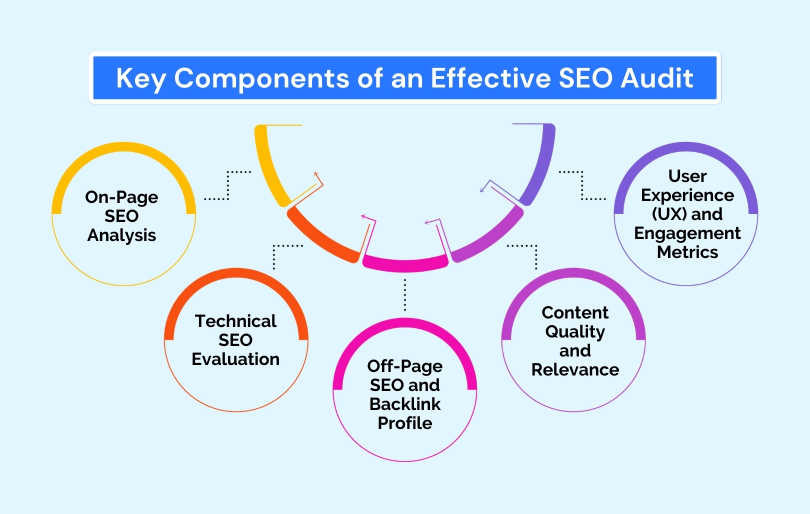
An effective SEO audit is a critical step in optimizing your website for search visibility, user experience, and long-term digital success. It identifies weaknesses, uncovers opportunities, and ensures every element of your site aligns with modern search engine standards. To see this balance in action, compare the elements listed here with our deep dive into on‑page vs off‑page SEO.
On-Page SEO Analysis
On-page SEO focuses on optimizing individual web pages to improve their rankings. This includes assessing title tags, meta descriptions, header hierarchy, keyword placement, internal linking, and content quality to ensure your pages are both relevant and search-engine friendly.
Technical SEO Evaluation
Technical SEO addresses how well search engines can crawl, index, and render your website. Core areas include site speed, mobile responsiveness, URL structure, structured data, and XML sitemaps—each vital for improving visibility and enhancing the overall user experience.
Off-Page SEO and Backlink Profile
Off-page SEO analyzes the authority and trustworthiness of your website. This involves evaluating your backlink profile, removing toxic links, and identifying opportunities to gain high-quality backlinks from credible sources that boost rankings and online reputation.
Content Quality and Relevance
An audit should evaluate whether your content aligns with user intent, includes targeted keywords, and offers real value. High-performing content is informative, engaging, and optimized for featured snippets, voice search, and semantic SEO strategies.
User Experience (UX) and Engagement Metrics
Google rewards websites that offer seamless, user-friendly experiences. Key UX signals like bounce rate, time on site, and click-through rates are analyzed during the audit to ensure your website encourages engagement and conversions.
Tools and Resources for Conducting SEO Audits
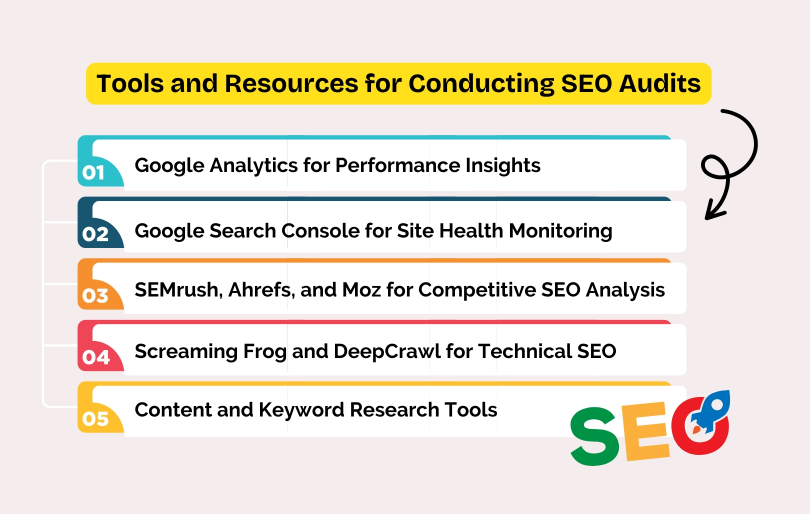
To perform a successful SEO audit, leveraging the right tools is essential. These platforms help uncover technical issues, evaluate performance metrics, and guide data-driven strategies to enhance search visibility and website health—all crucial for long-term SEO success. Many of the insights below come from hands‑on testing inside today’s AI‑powered SEO tools.
Google Analytics for Performance Insights
Google Analytics allows you to track user behavior, traffic sources, and conversion rates. These metrics help identify underperforming pages, assess content effectiveness, and optimize your marketing funnel with real-time, actionable data.
Google Search Console for Site Health Monitoring
Search Console reveals how Google views your site. It uncovers indexing issues, search performance metrics, mobile usability errors, and security problems—all vital for improving visibility and ensuring a clean crawl path.
SEMrush, Ahrefs, and Moz for Competitive SEO Analysis
These all-in-one SEO platforms offer tools for keyword research, backlink audits, content gap analysis, and rank tracking. They help benchmark your performance against competitors and identify high-impact opportunities for growth.
Screaming Frog and DeepCrawl for Technical SEO
These crawling tools scan your site for errors like broken links, duplicate content, redirect chains, and missing metadata. Their detailed reports make it easier to optimize site structure and improve crawlability and indexation.
Content and Keyword Research Tools
Tools like Ubersuggest, AnswerThePublic, and Keyword Planner help you discover new content opportunities, monitor search intent, and fine-tune your keyword strategy—essential for creating SEO-friendly, high-performing content.
Analyzing On-Page SEO Factors
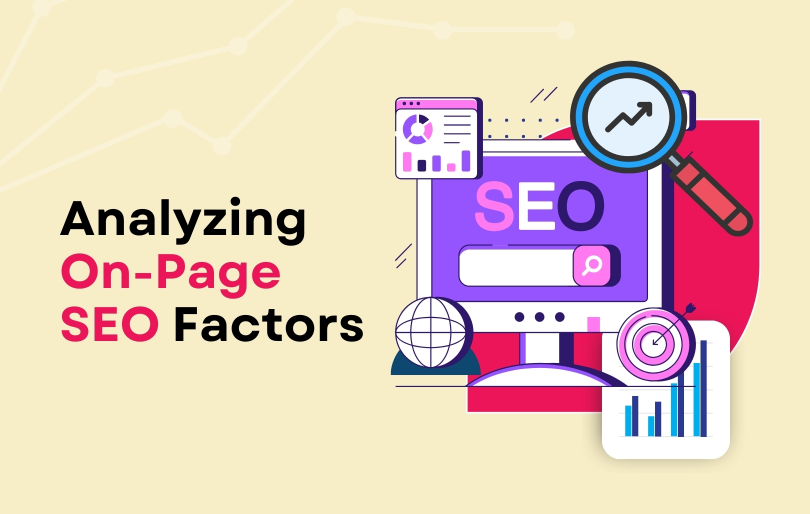
On-page SEO is a fundamental aspect of your website’s overall SEO strategy. It involves optimizing individual pages to improve their search engine rankings and attract more organic traffic. One of the first steps in analyzing on-page SEO factors is to review your title tags and meta descriptions. These elements should be unique, descriptive, and include relevant keywords to help search engines understand the content of your pages.
Next, it’s important to evaluate your header tags (H1, H2, H3, etc.). Header tags help structure your content and make it easier for both users and search engines to navigate. Ensure that your H1 tag is used for the main heading of the page and that subsequent headers follow a logical hierarchy. This not only improves readability but also enhances the SEO value of your content.
Content quality is another crucial on-page SEO factor. Your content should be informative, engaging, and relevant to your target audience. It should also include keywords naturally and provide value to users. Additionally, consider using multimedia elements like images, videos, and infographics to enrich your content and improve user engagement. By focusing on these on-page SEO factors, you can create a solid foundation for your website’s search engine performance.
Evaluating Technical SEO Aspects

Technical SEO plays a crucial role in ensuring that your website is accessible, crawlable, and indexable by search engines. One of the first aspects to evaluate in a technical SEO audit is site speed. A fast-loading website not only provides a better user experience but also positively impacts your search engine rankings. Use tools like Google PageSpeed Insights to identify areas where you can improve your site’s speed, such as optimizing images, leveraging browser caching, and minimizing JavaScript.
Mobile-friendliness is another important technical SEO factor. With the increasing use of mobile devices for browsing the internet, it’s essential that your website is responsive and provides a seamless experience across all devices. Use Google’s Mobile-Friendly Test to check if your site is optimized for mobile and make necessary adjustments to improve its performance.
Website architecture and internal linking structure are also critical technical SEO elements. A well-organized site structure ensures that search engines can easily crawl and index your pages. Create an XML sitemap and submit it to Google Search Console to help search engines understand your site’s structure. Additionally, ensure that your internal linking is logical and helps users navigate your site efficiently. By addressing these technical SEO aspects, you can improve your website’s overall performance and search engine rankings. Mobile readiness is non‑negotiable; review the key elements of mobile‑friendly web design to ensure your fixes hold up.
Assessing Off-Page SEO and Backlink Profiles
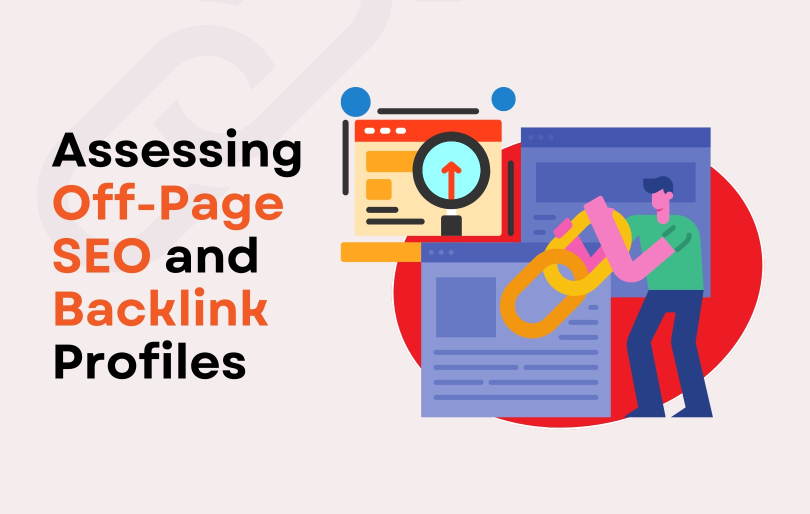
Off-page SEO is an essential component of your overall SEO strategy, as it involves activities that take place outside your website to improve its authority and visibility. One of the key aspects of off-page SEO is your backlink profile. Backlinks are links from other websites that point to your site. High-quality backlinks from authoritative and relevant websites can significantly boost your site’s credibility and search engine rankings.
During an SEO audit, it’s important to assess the quality and quantity of your backlinks. Tools like Ahrefs, SEMrush, and Moz can help you analyze your backlink profile and identify potential issues. Look for toxic or low-quality links that may harm your site’s reputation and take steps to disavow them. Additionally, identify opportunities to acquire high-quality backlinks through outreach, guest posting, and content marketing strategies.
Another important aspect of off-page SEO is your online reputation. Monitor mentions of your brand across the internet and engage with your audience on social media platforms. Positive reviews and user-generated content can enhance your brand’s credibility and attract more organic traffic. By focusing on these off-page SEO factors, you can improve your website’s authority and drive more traffic to your site. When pruning and building links, lean on principles from our tutorial on the art of link building for SEO.
Identifying Content Gaps and Opportunities

Content is the backbone of your website and plays a crucial role in attracting and engaging users. Identifying content gaps and opportunities is an essential part of an SEO audit. Start by analyzing your existing content to determine which topics are performing well and which ones need improvement. Use tools like Google Analytics and Google Search Console to identify pages with high bounce rates or low engagement and consider updating or optimizing them.
Next, conduct keyword research to identify new content opportunities. Look for keywords that have high search volume and low competition, and create content that addresses these topics. Additionally, consider creating content that targets long-tail keywords, as these can attract highly targeted traffic and improve your chances of ranking higher in search results.
Another strategy for identifying content opportunities is to analyze your competitors’ content. Look for gaps in their content strategy and create high-quality content that fills those gaps. By consistently producing valuable and relevant content, you can attract more organic traffic, improve user engagement, and enhance your website’s overall SEO performance. If you discover thin spots, follow the frameworks in content creation for beginners to fill them with value.
Setting SEO Goals and KPIs for 2025
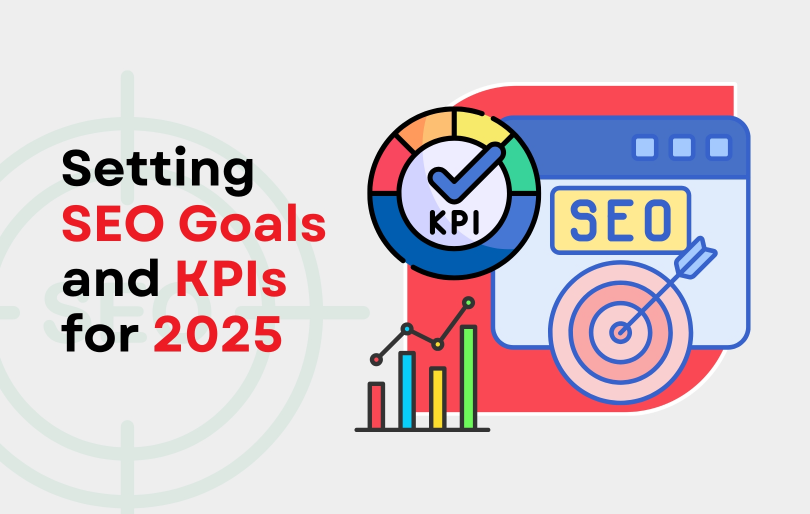
Setting clear and measurable SEO goals is essential for tracking your progress and ensuring the success of your SEO strategy. Start by defining your primary objectives, such as increasing organic traffic, improving search engine rankings, or boosting conversion rates. Once you have established your goals, identify key performance indicators (KPIs) that will help you measure your progress.
Some common SEO KPIs include organic traffic, keyword rankings, bounce rate, page load time, and conversion rate. Use tools like Google Analytics and Google Search Console to track these metrics and monitor your performance over time. Additionally, set specific targets for each KPI and establish a timeline for achieving them. This will help you stay focused and motivated as you work towards your SEO goals.
It’s also important to regularly review and adjust your goals and KPIs based on your performance and changes in the digital landscape. Stay informed about the latest SEO trends and algorithm updates, and be prepared to adapt your strategy as needed. By setting clear SEO goals and tracking your progress, you can ensure the long-term success of your SEO efforts and stay ahead of the competition.
Implementing Changes and Tracking Progress
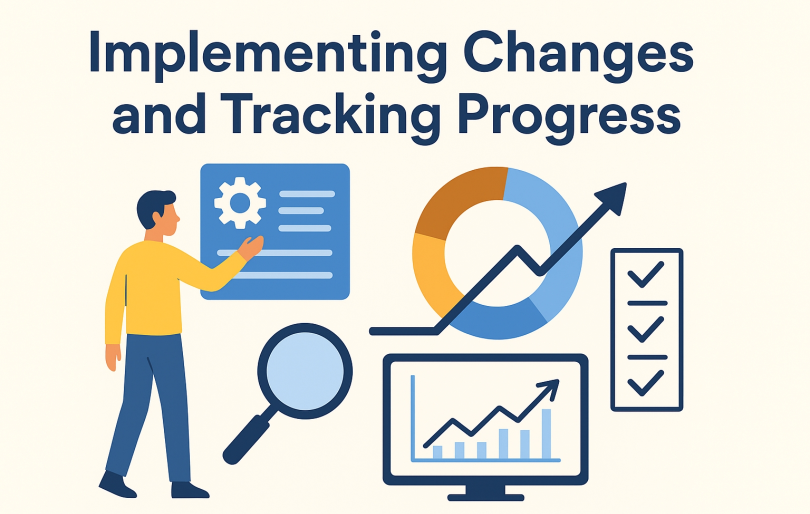
Once you have conducted a thorough SEO audit and identified areas for improvement, it’s time to implement the necessary changes. Start by prioritizing the issues that have the most significant impact on your website’s performance. This may include optimizing on-page elements, improving site speed, addressing technical issues, or acquiring high-quality backlinks. Create a detailed action plan that outlines the steps you need to take and assign responsibilities to your team members.
As you implement these changes, it’s essential to track your progress and measure the impact of your efforts. Use tools like Google Analytics, Google Search Console, and other SEO software to monitor your performance and track key metrics. Regularly review your progress and compare it to your initial goals and KPIs. This will help you determine whether your SEO strategy is working and identify any areas that may need further optimization.
Additionally, consider conducting periodic SEO audits to ensure your website remains optimized and aligned with best practices. The digital landscape is constantly evolving, and regular audits will help you stay ahead of the curve and maintain your competitive edge. By implementing changes and tracking your progress, you can continuously improve your website’s SEO performance and achieve long-term success. Document improvements in clear dashboards—our guide to creating SEO reports for clients shows an effective layout.
Future Trends in SEO Auditing for 2025 and Beyond
As we look towards 2025 and beyond, several emerging trends are likely to shape the future of SEO auditing. One of the most significant trends is the increasing importance of artificial intelligence (AI) and machine learning in search engine algorithms. AI-powered tools like Google’s RankBrain are becoming more sophisticated and capable of understanding user intent and delivering more relevant search results. To stay competitive, it’s essential to optimize your content for user intent and focus on providing high-quality, valuable information.
Voice search is another trend that is expected to grow in popularity. With the rise of smart speakers and virtual assistants like Amazon Alexa and Google Assistant, more users are conducting searches using voice commands. This shift requires a new approach to keyword research and content optimization, as voice searches tend to be more conversational and longer in nature. Optimizing your content for voice search can help you capture this growing segment of users and improve your search engine rankings.
Finally, the focus on user experience (UX) is likely to become even more critical in the future. Search engines are increasingly prioritizing websites that provide a seamless and engaging user experience. Factors like site speed, mobile-friendliness, and content quality will continue to play a significant role in determining your search engine rankings. By staying informed about these trends and incorporating them into your SEO strategy, you can ensure your website remains competitive and well-optimized for the future. Staying AI‑aware is essential; explore emerging ranking shifts in AI in digital marketing to future‑proof your tactics.
In conclusion, mastering your SEO audit for 2025 requires a comprehensive and proactive approach. By understanding the importance of an SEO audit, analyzing key components, leveraging the right tools, and staying informed about emerging trends, you can optimize your website and improve your search engine rankings. Remember that SEO is an ongoing process, and regular audits are essential for maintaining your competitive edge and achieving long-term success. Embrace the challenges and opportunities that come with the ever-evolving digital landscape, and unlock the full potential of your website. Ready to audit with experts? Book an SEO audit by Adzeem agency in Maryland today.
